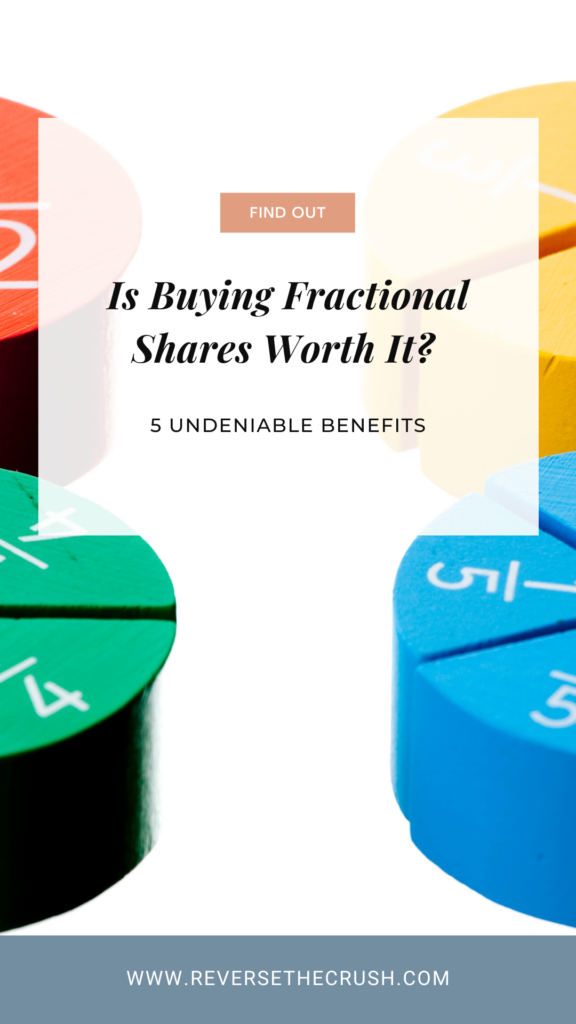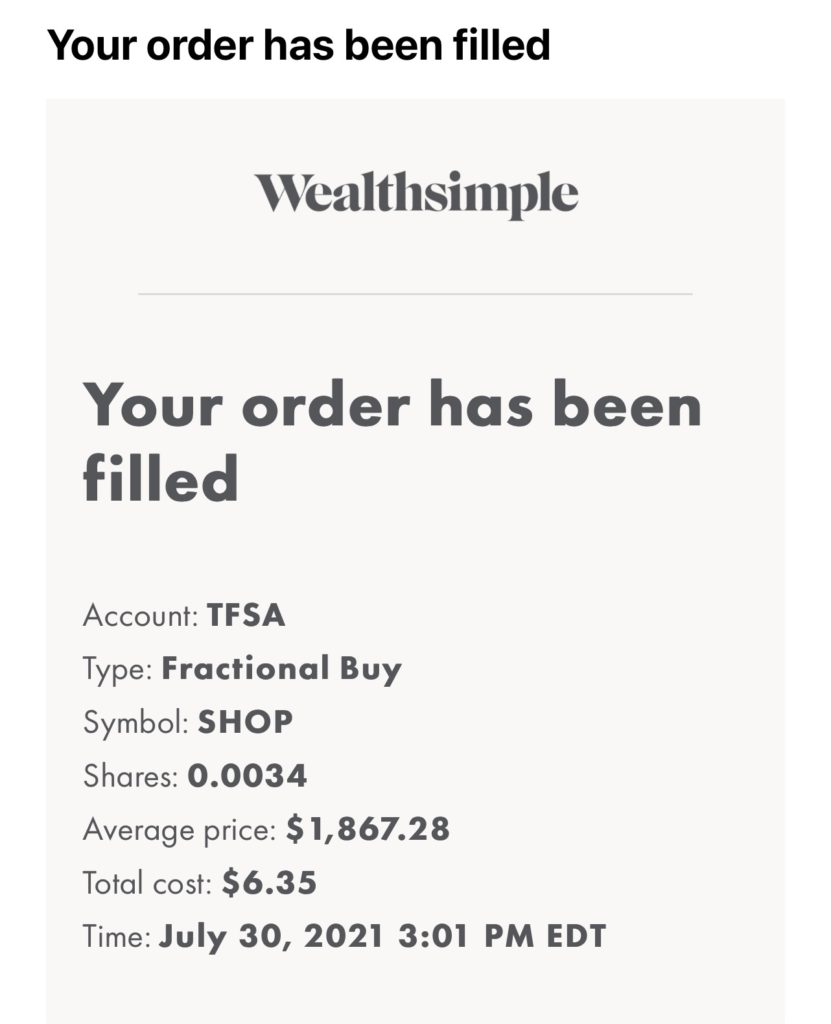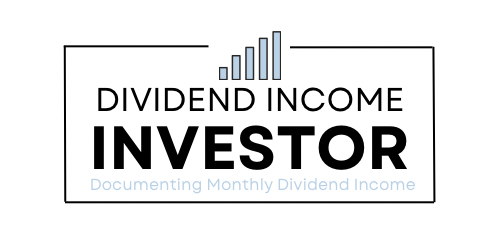Is buying fractional shares worth it? Exploring what fractional shares are and looking at 5 undeniable benefits of fractional investing. I am not a licensed investor and this post is not investment advice. This article is for entertainment purposes only. This post may contain affiliate links.
I recently began investing in fractional shares of Shopify because Wealthsimple started offering it.
As such, I decided to review my experience to help you decide if fractional investing makes sense for your portfolio.
So, is buying fractional shares worth it?
In this article, I will review what fractional shares are and look at 5 undeniable benefits of buying them.
Let’s get started.

What Are Fractional Shares?
The term fractional shares is fairly self-explanatory.
In short, a fractional share is a fraction of a share of a stock.
Until recently, investors were only able to buy one share of a stock at a time.
Since some stocks trade at a high cost per share, such as Amazon at over $3,000 per share, this meant that an investor needed to have at least $3,000 plus the cost of commission to invest in it.
Nowadays, though, because of zero-commission brokerages and fractional trading, it’s possible to invest for as little as $1.
With fractional investing, investors can own a fraction of a share of stock.
Is Buying Fractional Shares Worth It?
The question is: is buying fractional shares worth it?
Is it even worthwhile to invest with such a small sum of money?
To that, I would say, absolutely yes.
If you are new to investing or you are investing with little money, there are plenty of reasons to buy fractional shares.
Here are 5 undeniable benefits of buying fractional shares:

1. Better Diversification
One of the main reasons why fractional shares make sense is they help investors diversify their portfolio.
When you are investing with little money, it’s next to impossible to properly diversify your portfolio unless you invest in index funds or ETFs.
However, fractional shares make it possible to own small amounts of stocks in different industries. Therefore, it’s easier than ever to diversify your portfolio.
2. Access To Better Quality Stocks
Often times, new investors are forced to avoid quality stocks because the share prices are too high.
They simply can’t afford to buy stocks such as Amazon ($3,327.59), Alphabet ($2,694.53), Tesla ($687.20), Shopify ($1,873.00), Apple ($145.86), or Microsoft ($284.91).
The problem is that avoiding quality stocks is bad for your portfolio’s return.
I mean, it’s not a great investment strategy to invest in worse quality stocks just because the price is cheaper.
Simply put, fractional investing provides investors with access to better quality stocks.
3. Ability To Invest With Less Money
Of course, the main advantage of fractional investing is that is allows investors to invest with less money.
Instead of saving up thousands to invest, investors can now start investing with as little as $1. Instead of saving up $120,000 to put a 20% downpayment on a $600,000 house, it’s possible to start increasing your net worth with a small amount of money.
It is absolutely incredible how far investing has come over the last decade.
I used to have to pay $28.95 per trade when I started investing. Now, I can invest in the best companies in the world commission-free for as little as $1.
For new investors with less money, this is phenomenal. Investing is no longer a game that is only suitable to the rich. Anyone can do it.
4. Put All Your Cash To Work
Considering that inflation erodes the buying power of money, I’m not someone who likes to have cash sitting around.
The only way I will have cash sitting around is if it’s for a short-term goal or specific purpose, such as buying a house.
Fortunately, fractional investing allows investors to put all their cash to work right away.
Instead of letting worthless cash build up in your account until you have enough to buy a stock, you can invest it right away.
This works great if you are the type of investor who dollar cost averages into stocks.
5. Reinvest Your Dividends
As a dividend investor, I try to reinvest my dividends right away to grow my dividend income.
But sometimes the dividend payments are too small to be able to afford additional shares.
In the past, I would have to wait until more dividend payments are deposited or until my next payday to be able to invest.
Because of fractional investing, though, I am able to reinvest all my dividends immediately. That is regardless of how small they are.
For example, I received a small dividend from Bank of Nova Scotia yesterday worth $6.30.
Normally, this wouldn’t be enough to invest. However, thanks to fractional investing, I was able to reinvest my dividends right away and add to my Shopify position.
Furthermore, fractional investing can also be used to acquire dividend stocks and increase dividend income.
Disadvantages Of Fractional Investing
Of course, everything in life comes with its share of tradeoffs.
Investing in fractional shares is no exception.
Although fractional shares have many benefits, there are a few downsides as well.
Mainly, fractional shares offer less liquidity than owning full shares. They trade more like mutual funds than traditional stocks. When you place an order to buy fractional shares, the order is usually filled at the end of the day.
Otherwise, the only other downside I can think of is that there are limited fractional share options available.
At this point, my brokerage, Wealthsimple, only has 14 stocks available for fractional investing.
However, I don’t see this as too much of a problem because the main stocks are available.

Where Can You Buy Fractional Shares?
If you are a Canadian investor, you have two options: Wealthsimple or Interactive Brokers.
I am currently using Wealthsimple to buy fractional shares of Shopify. I would highly recommend them. If you want to start buying fractional shares, check out my link to learn more and get two free stocks.
Alternatively, if you are a U.S. investor, you have many more options to consider. Since I do not have any experience with any U.S. brokers, I will just list off a few options for you to research. U.S. investors can consider the following brokerages to buy fractional shares: Robinhood, M1 Finance, Fidelity, Public, Schwab, Betterment, Stockpile, and Stash.

Is Buying Fractional Shares Worth It? – Final Thoughts
So, is buying fractional shares worth it?
Yes, it’s absolutely worth it.
Buying fractional shares has many benefits, such as the following:
- Better diversification
- Access to better quality stocks
- Provides the ability to invest with less money
- Allows investors to put all their cash to work
- Reinvest all dividends
However, there are some downsides to fractional shares, such as less liquidity and limited selection.
But overall, the advantages outweigh the disadvantages and buying fractional shares is totally worth it.
If you are looking to invest in fractional shares, check out Wealthsimple to get two free stocks here.
Have you tested out fractional investing? Do you own any fractional shares? What brokerage do you use to invest in fractional shares?
I’d love to hear your thoughts in the comments below.
Check Out These Articles On Investing
How To Dollar Cost Average: 7 Tips To Turn Investing Into A Habit
How Many Stocks Should You Own?
Should Dividend Investors Use Margin?
I am not a licensed investment or tax adviser. All opinions are my own. This post may contain advertisements by Monumetric and Google Adsense. This post may also contains internal links, affiliate links to BizBudding, Amazon, Bluehost, and Questrade, links to trusted external sites, and links to RTC social media accounts.
Connect with RTC
Twitter: @Reversethecrush
Pinterest: @reversethecrushblog
Instagram: @reversethecrush_
Facebook: @reversethecrushblog
Email: graham@reversethecrush.com


 Display Ads Pros and Cons
Display Ads Pros and Cons
